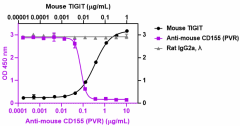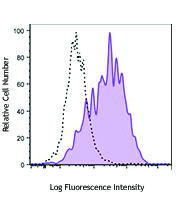- Clone
- A18179E (See other available formats)
- Regulatory Status
- RUO
- Other Names
- PVR, PVS, Nectin-like molecule-5, Nectin-like protein 5, NECL5, NECL-5, Poliovirus receptor
- Isotype
- Rat IgG2a, λ
- Ave. Rating
- Submit a Review
- Product Citations
- publications

-

Biotinylated recombinant mouse TIGIT (black circles) binds to immobilized recombinant mouse CD155-Fc chimera (Cat. No. 786606). Ultra-LEAF™ purified anti-mouse CD155 (PVR) antibody (clone A18179E) (purple squares) inhibits the binding in a dose-dependent manner whereas the rat IgG2a, λ isotype ctrl antibody (gray triangles) does not have the effect. This antibody blocks the binding of 0.2 µg/mL biotinylated recombinant mouse TIGIT to 1 µg/mL immobilized recombinant mouse CD155-Fc chimera. ND50 = 0.05 – 0.25 µg/mL.
| Cat # | Size | Price | Save |
|---|---|---|---|
| 942103 | 100 µg | ¥59,430 | |
| 942104 | 1 mg | ¥173,470 |
CD155, also known as TAGE4 or NECL-5 (nectin-like molecule-5), was originally described as a poliovirus entry receptor (PVR) more than 30 years ago. CD155 is a 70 kD type I transmembrane glycoprotein that belongs to the nectin-related family of adhesion molecules within the immunoglobulin superfamily, defined by the presence of immunoglobulin domains V, a C1-like domain and a C2 domain in the extracellular region. CD155 binds several molecules including vitronectin, nectin-3, DNAM-1/CD226, CD96, and TIGIT. All bindings are mediated by the V-type domain and alternative splicing within this domain can modulate ligand binding. CD155 is highly expressed on tumor cells of epithelial and neuronal origin. Its enhanced expression in tumors contributes to the loss of contact inhibition leading to increased migration, however, tumor cell recognition and killing by NK cells are also enhanced via DNAM-1 or CD96 expressing NK cells. CD155 normally functions in the establishment of intercellular adherent junctions between epithelial cells. CD155 mediates NK cell adhesion and triggers NK cell effector functions by binding to CD96 and CD226. These interactions accumulates at the cell-cell contact site, leading to the formation of a mature immunological synapse between NK cell and target cells.
Product DetailsProduct Details
- Verified Reactivity
- Mouse
- Antibody Type
- Monoclonal
- Host Species
- Rat
- Immunogen
- Recombinant mouse CD155
- Formulation
- 0.2 µm filtered in phosphate-buffered solution, pH 7.2, containing no preservative.
- Endotoxin Level
- Less than 0.01 EU/µg of the protein (< 0.001 ng/µg of the protein) as determined by the LAL test.
- Preparation
- The Ultra-LEAF™ (Low Endotoxin, Azide-Free) antibody was purified by affinity chromatography.
- Concentration
- The antibody is bottled at the concentration indicated on the vial, typically between 2 mg/mL and 3 mg/mL. Older lots may have also been bottled at 1 mg/mL. To obtain lot-specific concentration and expiration, please enter the lot number in our Certificate of Analysis online tool.
- Storage & Handling
- The antibody solution should be stored undiluted between 2°C and 8°C. This Ultra-LEAF™ solution contains no preservative; handle under aseptic conditions.
- Application
-
Blocking - Quality tested
- Recommended Usage
-
Each lot of this antibody is quality control tested by blocking the binding of 0.2 µg/mL biotinylated recombinant mouse TIGIT to 1 µg/mL immobilized recombinant mouse CD155-Fc chimera. ND50 = 0.05 – 0.25 µg/mL. It is recommended that the reagent be titrated for optimal performance for each application.
- RRID
-
AB_2890862 (BioLegend Cat. No. 942103)
AB_2890862 (BioLegend Cat. No. 942104)
Antigen Details
- Structure
- Disulfide-linked homodimer
- Distribution
-
Highly expressed on immature thymocytes, lymph node dendritic cells, and tumor cells of epithelial and neuronal origin, preferentially expressed on Th17 cells.
- Function
- Mediates NK cell adhesion and triggers NK cell effector functions
- Interaction
- NK cell, T cell
- Ligand/Receptor
- Vitronectin, nectin-3, DNAM-1/CD226, CD96, and TIGIT
- Cell Type
- Dendritic cells, Th17, Thymocytes
- Biology Area
- Adaptive Immunity, Cell Adhesion, Cell Motility/Cytoskeleton/Structure, Neuroscience
- Molecular Family
- Adhesion Molecules, Soluble Receptors
- Antigen References
-
1. He Y, et al. 2000. Proc. Natl. Acad. Sci. USA. 97:79-84.2. Bottino C, et al. 2003. J. Exp. Med. 198:557-67.3. Fuchs A, et al. 2004. J. Immun. 172: 3994-3998.4. Reymond N, et al. 2004. J. Exp. Med. 199:1331-41.5. Koike S, et al. 1990. EMBO J. 9: 3217-3224.6. Mendelsohn CL, et al. 1989. Cell 56:855-65.
- Gene ID
- 52118 View all products for this Gene ID
- UniProt
- View information about CD155 on UniProt.org
Related FAQs
- Do you guarantee that your antibodies are totally pathogen free?
-
BioLegend does not test for pathogens in-house aside from the GoInVivo™ product line. However, upon request, this can be tested on a custom basis with an outside, independent laboratory.
- Does BioLegend test each Ultra-LEAF™ antibody by functional assay?
-
No, BioLegend does not test Ultra-LEAF™ antibodies by functional assays unless otherwise indicated. Due to the possible complexities and variations of uses of biofunctional antibodies in different assays and because of the large product portfolio, BioLegend does not currently perform functional assays as a routine QC for the antibodies. However, we do provide references in which the antibodies were used for functional assays and we do perform QC to verify the specificity and quality of the antibody based on our strict specification criteria.
- Does BioLegend test each Ultra-LEAF™ antibody for potential pathogens?
-
No, BioLegend does not test for pathogens in-house unless otherwise indicated. However, we can recommend an outside vendor to perform this testing as needed.
- Have you tested this Ultra-LEAF™ antibody for in vivo or in vitro applications?
-
We don't test our antibodies for in vivo or in vitro applications unless otherwise indicated. Depending on the product, the TDS may describe literature supporting usage of a particular product for bioassay. It may be best to further consult the literature to find clone specific information.
Other Formats
View All CD155 Reagents Request Custom Conjugation| Description | Clone | Applications |
|---|---|---|
| Ultra-LEAF™ Purified anti-mouse CD155 (PVR) Antibody | A18179E | Block |
Customers Also Purchased
Compare Data Across All Formats
This data display is provided for general comparisons between formats.
Your actual data may vary due to variations in samples, target cells, instruments and their settings, staining conditions, and other factors.
If you need assistance with selecting the best format contact our expert technical support team.
-
Ultra-LEAF™ Purified anti-mouse CD155 (PVR) Antibody

Biotinylated recombinant mouse TIGIT (black circles) binds t...













Follow Us